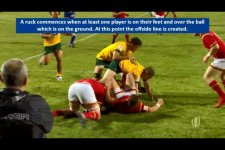Treadmore
Avid Rugby Lover
- Joined
- Nov 11, 2008
- Messages
- 413
- Post Likes
- 38
A still I have cropped from the powerpoint.
The text book application of the offside line being set. Ruck formed, referee sets the Offside line (by reference to something/somebody who knows what) and SH (rather than rucking players) coming in and doing a text book pick up and distribution.
And that's as good as it gets from WR! One example from the U20 RWC that will help all this confusion just melt away!
View attachment 3588
That clip caption omits reference to a tackle, which is in the ruck definition text in the slide:
[LAWS]
A ruck commences when at least one player is on their feet and over
the ball which is on the ground (tackled player, tackler).[/LAWS]
Is this trial just about the tackle situation? I had assumed that, otherwise it could be a bit chaotic!
Slightly off-topic, just before your screenshot we have Gold 14 off-feet:

the clip ends with penalty advantage to gold for red offside at the mono (duo?) ruck :sad:





